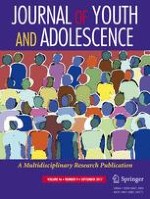13-06-2017 | Empirical Research
Is Sexual Activity During Adolescence Good for Future Romantic Relationships?
Gepubliceerd in: Journal of Youth and Adolescence | Uitgave 9/2017
Log in om toegang te krijgenAbstract
Past research has consistently shown that romantic experiences during adolescence affect the nature and quality of romantic relationships during emerging adulthood. However, less is known about the role of adolescent sexual experiences in future sexual and romantic relationships. The current study examined the impact of different forms of sexual activity at age 16 (within a romantic relationship or casual encounters) on the nature and quality of sexual experiences in romantic relationships at age 23. One hundred and forty four (59.7% females) 16 year olds reported on their sexual activity within a romantic relationship or sexual encounters. In addition they reported on the quality of relationships they were involved in and their tendency to suppress emotions (included as an aspect of personality). At age 23 they reported on their romantic and sexual experiences during the past 2 years (number of short lived relationships, numbers of friends with benefits, casual sex encounters) and the quality of their romantic relationships (the duration of their longest relationship, partner support and feelings of certainty in the relationships). Findings showed that the tendency to suppress emotions was associated with lower likelihood to engage in casual sex at age 23. However, greater sexual experience in casual encounters during adolescence was consistently longitudinally associated with different forms of casual sexual encounters and short romantic involvements above and beyond the contribution of personality. In contrast, sexual activity within a romantic relationship predicted only a few indices of the quality of romantic involvement at age 23. The distinctive role of casual sexual activity and sexual activity within a romantic relationship for future sexual and romantic activities is discussed.
